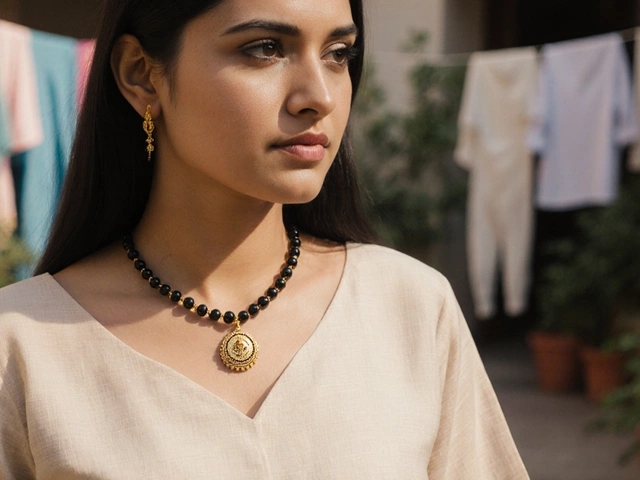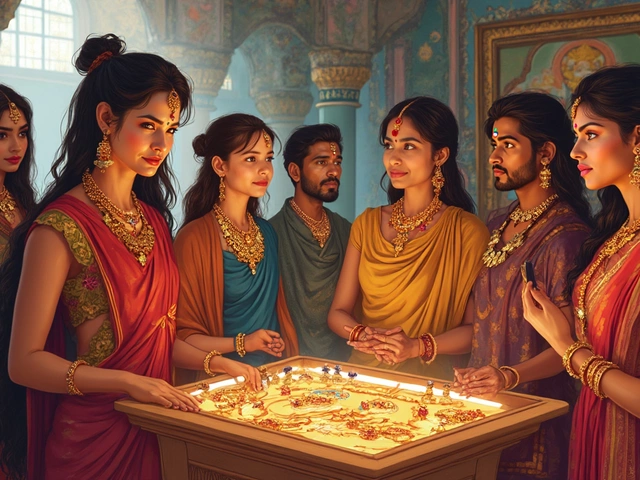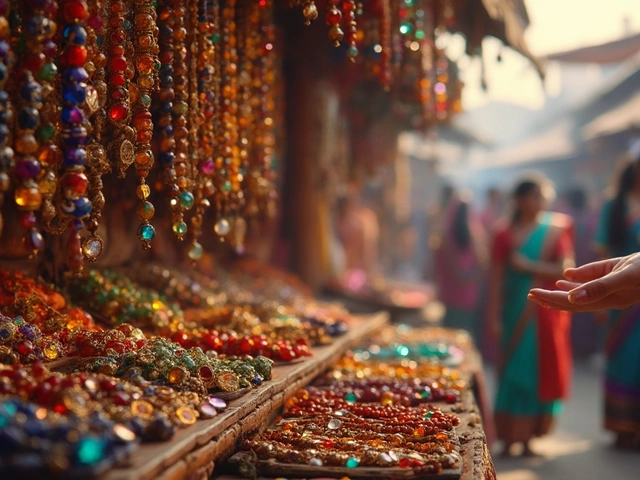Ever noticed that bright splash of red on a woman's wrist in India and wondered what it stands for? Red bangles here are a big deal—they aren’t just stylish but carry heaps of meaning. Slide one of these on, and you’re not just accessorizing; you’re echoing a rich tapestry of culture and tradition.
Red is all about love, fire, and festivity. So, when a newlywed walks out with red bangles, it's like she's wrapped a piece of their vibrant traditions around her wrist. It's about announcing to the world that she's taken, and happily so! While these bangles might scream marriage, they also whisper tales of happiness, prosperity, and a dash of cultural legacy that’s been passed down through generations.
- The Cultural Significance of Red Bangles
- Regional Variations in Bangle Styles
- Why Married Women Wear Red Bangles
- Materials Used for Making Red Bangles
- Occasions to Wear Red Bangles
- Tips for Choosing the Right Red Bangles
The Cultural Significance of Red Bangles
In India, red isn't just a color; it’s a whole mood steeped in tradition. When it comes to bangles, the red bangle meaning is deeply ingrained in cultural beliefs. Often associated with marriage, these vibrant bangles are donned by brides and married women as a symbol of love and fidelity. It's like wearing a small part of their marital vows on their wrists.
The roots of this tradition go way back to ancient times. In Hinduism, for instance, red symbolizes purity, energy, and prosperity, making it the perfect color for marriages and auspicious ceremonies. A woman wearing traditional red bangles is believed to bring good fortune and reinforce the sacred bond of her marriage.
But it’s not just about the color. The sound of bangles clinking is considered auspicious, believed to ward off negative energy and invite positivity. This isn’t something confined to just one region; it’s an integral part of Indian wedding customs throughout the country. Each clink and every moment of wearing these bangles intertwines with shared stories and passed-down rituals.
The influence of these bangles extends beyond weddings. In various regional festivals, red bangles are a staple, showing the joyous mood of celebrations. Whether it's Holi, Diwali, or regional harvest festivals, red bangles add that zing that ties the whole attire together and enlivens the spirit of the occasion.
Interestingly, variations exist even within regions. In Punjab, for example, a bride might wear 'Chooda,' a special set of red and white bangles, while in Maharashtra, green bangles often accompany red ones. These subtle differences not only show cultural diversity but also highlight how Indian bangle symbolism varies, yet resonates universally across the country.
Regional Variations in Bangle Styles
India being the culturally rich place it is, you won’t be surprised to know that traditional bangles vary quite a bit from one region to the next. These variations aren't just in terms of appearance but also in the materials used and the stories they tell.
Take Rajasthan, for instance. Rajasthani bangles are often made from lac, a natural resin. They've got this cool glossy finish and are decorated with mirrors, giving them a totally unique sparkle. Jump over to Bengal, and you'll see married women rocking red and white bangles called shakha-pola. These are made from shell and coral, respectively, symbolizing purity and prosperity.
In Punjab, the playful and vibrant chooda set often takes center stage in weddings. These are usually red and white, too, but made from ivory or plastic today, and are worn in stacks. Contrast this with South India, where gold is prominently used. Gold bangles from Kerala and Tamil Nadu are coveted not just for their bling factor but also as family heirlooms.
A quick trip to the bustling markets or local festivals can show you the fascinating diversity. From glass and metal to wooden versions, each bangle is a mini-story, reflecting the culture and traditions of its place of origin.
To give a snapshot of this variety, here’s a simple overview:
| Region | Material | Signature Style |
|---|---|---|
| Rajasthan | Lac | Glossy, Mirrored |
| Bengal | Shell & Coral | Simple, Red-White |
| Punjab | Ivory/Plastic | Stacked Chooda |
| South India | Gold | Heavy, Intricate |
So next time you see someone sporting red bangles, you might just see more than jewelry—you see a slice of where they come from and what they stand for.
Why Married Women Wear Red Bangles
Dive into any traditional Indian ceremony, and you'll quickly spot newlyweds flaunting those iconic red bangles. But why, you might ask, do married women in India prioritize this vibrant hue? It’s not just about fashion; these bangles are loaded with cultural importance.
The color red, in Indian tradition, symbolizes love, commitment, and prosperity. For a married woman, wearing red bangles signifies her marital status, echoing the vows she’s taken at her wedding. It’s like wearing a wedding ring, but with a cultural twist that ties into rituals and regional beliefs.
There’s also a belief that these bangles bring good fortune and longevity to her spouse. In many parts of India, especially the north, it's customary for the bride to wear a set of red bangles made from glass or lacquer during her wedding. This jewelry serves as a marker of her new life chapter and, some say, enhances the harmony in her marriage.
The practice extends beyond mere tradition, having a psychological layer too. For instance, wearing these bangles keeps marital memories fresh and vibrant, easily sparking joyous recollections of the wedding day.
So, while they might seem like simple jewelry, red bangles play a deeper role in celebrating love and unity, crafting a moving narrative on any married woman’s hand.

Materials Used for Making Red Bangles
So, you’ve got all these gorgeous red bangles staring at you, but do you ever think about what they’re made of? In India, we've got a mix of materials, each bringing its own vibe and story to these circular treasures. The choice often depends on the region, occasion, and personal taste.
Let’s start with glass, shall we? Glass bangles are probably the first thing that pops into mind. They're sparkly, make a cheerful clinking sound, and come in every shade of red you can dream up. That's why they are a hit during weddings and festivals. But, don’t let the delicate look fool you. Though they can break easily, the beauty they add to a woman’s wrist is worth the care and caution.
Then there’s metal, like gold-plated or even solid gold. Yep, you’re talking serious heirloom stuff here. These are on a different price orbit but scream elegance and a rich tradition. Metal bangles can be plain or have intricate designs, sometimes even embellished with stones or enamel work.
Plastic bangles are common too, a solid budget-friendly option. They mimic the look of glass without the fragility, and they're perfect for casual everyday wear. Looking for something that’s a bit more high-end than plastic? Lac bangles might be your answer. Lac is a natural resin, giving bangles a glossy finish. These are hand-molded and often come adorned with stones, adding that extra bling.
Sometimes, you’ll even find bangles made of ivory or shell, though they're not as common now. With increasing awareness of ethical sourcing, these materials have taken a backseat.
Curious about how popular some less traditional materials are getting? Check this out:
| Material | Popularity (%) |
|---|---|
| Glass | 45 |
| Metal (Gold) | 20 |
| Plastic | 15 |
| Lac | 15 |
| Others (Shell, Ivory) | 5 |
So, when it comes to choosing your next set of traditional bangles, think about the material’s look and feel, how often you’ll wear them, and the statement you want to make. Every material has its perks and quirks, so go on and bang on bashfully!
Occasions to Wear Red Bangles
Red bangles come into the spotlight mostly during weddings and festive seasons in India. It's like they steal the show, becoming an essential part of a bride's outfit. You can spot these beauties sparkling in the vibrant chaos of an Indian wedding, often paired with a traditional saree or lehenga. That's because red in Indian culture signifies love and prosperity, making it an absolute favorite for such big celebrations.
Besides weddings, you’ll find women rocking those red bangles during festivals like Diwali and Karva Chauth. Diwali is a festival of lights, so naturally, it calls for a bit of color and sparkle. During Karva Chauth, married women fast and pray for their husbands' long lives while wearing these traditional bangles, adding to the emotional value they carry.
But hey, it's not just about these heavyweight occasions. In regions like Punjab, women also wear them during local festivities like Teej and Baisakhi, marking the harvest season with joy and color. And let’s not forget about those random days when they’re just feeling a bit extra or want to invite some good luck. That's because, beyond icons of marriage, they’re sometimes seen as good omen charms.
- Weddings and pre-wedding ceremonies
- Festivals like Diwali and Karva Chauth
- Regional festivities such as Teej and Baisakhi
- Casual days for added elegance or positive vibes
And here’s a quick tip: when you do decide to don red bangles outside these occasions, try mixing them up with bangles of different colors and metals for a more contemporary and personal touch. It’s a neat way to blend tradition with today’s fashion trends.
Tips for Choosing the Right Red Bangles
Picking out the perfect red bangle isn’t just about grabbing the first set you see. There’s a bit of thought and style involved; think about it like choosing the right accessory that matches not just your outfit, but also the occasion and your personality.
First off, consider the material. Traditional red bangles come in glass, gold, or lacquer. If you're aiming for authenticity and tradition, glass is your go-to. They're fragile but hold that classic look most people love for weddings. For something more enduring, gold bangles not only look elegant but also last longer.
Next, size matters. Bangles that are too tight might become uncomfortable, while loose ones can slip off too easily. To get it just right, measure across the broadest part of your palm when your hand is at ease. This should help you choose a size that’ll fit snugly but comfortably.
Don’t forget the design. While plain red bangles are timeless, many opt for ones embedded with small stones or intricate designs. If you’re attending a more traditional family event, bold and flashy could work wonders. For everyday wear, simpler is often the best choice.
- Match them with your outfit: If your saree or lehenga has gold or silver embroidery, choose bangles that feature similar metals or accents.
- Think about stacking: Mixing a few different designs or materials can give your wrist a fuller, more eclectic appearance.
- Durability: If you're someone who uses your hands a lot, like cooking or typing, go for sturdier materials that won't break easily.
Also, keep in mind the regional variations. A red bangle from Rajasthan might differ in design and significance from one in Maharashtra. It’s fascinating how these differences can add a deeper layer of meaning to your choice.
| Material | Pros | Cons |
|---|---|---|
| Glass | Authentic, Traditional | Fragile |
| Gold | Elegant, Durable | Expensive |
| Lacquer | Stylish, Affordable | Less Traditional |
Ultimately, whether it's for a special occasion or daily charm, choosing the right red bangles can really swing your style quotient up by a notch. They tell a story, connect you with culture, and can add a beautiful finish to your look.



